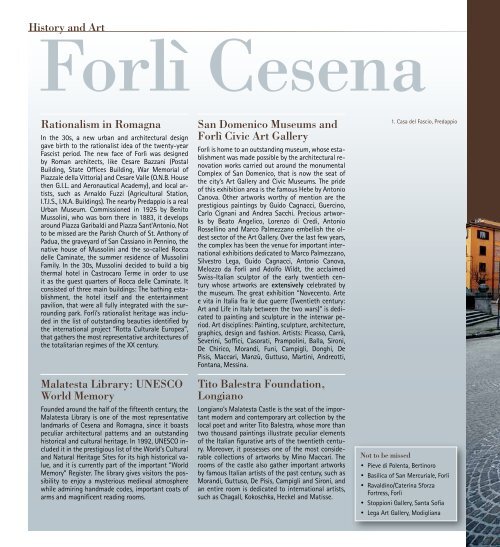of Emilia Romagna
of Emilia Romagna
of Emilia Romagna
Create successful ePaper yourself
Turn your PDF publications into a flip-book with our unique Google optimized e-Paper software.
History and Art<br />
Forlì Cesena<br />
Rationalism in <strong>Romagna</strong><br />
In the 30s, a new urban and architectural design<br />
gave birth to the rationalist idea <strong>of</strong> the twenty-year<br />
Fascist period. The new face <strong>of</strong> Forlì was designed<br />
by Roman architects, like Cesare Bazzani (Postal<br />
Building, State Offices Building, War Memorial <strong>of</strong><br />
Piazzale della Vittoria) and Cesare Valle (O.N.B. House<br />
then G.I.L. and Aeronautical Academy), and local artists,<br />
such as Arnaldo Fuzzi (Agricultural Station,<br />
I.T.I.S., I.N.A. Buildings). The nearby Predappio is a real<br />
Urban Museum. Commissioned in 1925 by Benito<br />
Mussolini, who was born there in 1883, it develops<br />
around Piazza Garibaldi and Piazza Sant’Antonio. Not<br />
to be missed are the Parish Church <strong>of</strong> St. Anthony <strong>of</strong><br />
Padua, the graveyard <strong>of</strong> San Cassiano in Pennino, the<br />
native house <strong>of</strong> Mussolini and the so-called Rocca<br />
delle Caminate, the summer residence <strong>of</strong> Mussolini<br />
Family. In the 30s, Mussolini decided to build a big<br />
thermal hotel in Castrocaro Terme in order to use<br />
it as the guest quarters <strong>of</strong> Rocca delle Caminate. It<br />
consisted <strong>of</strong> three main buildings: The bathing establishment,<br />
the hotel itself and the entertainment<br />
pavilion, that were all fully integrated with the surrounding<br />
park. Forlì’s rationalist heritage was included<br />
in the list <strong>of</strong> outstanding beauties identified by<br />
the international project “Rotta Culturale Europea”,<br />
that gathers the most representative architectures <strong>of</strong><br />
the totalitarian regimes <strong>of</strong> the XX century.<br />
Malatesta Library: UNESCO<br />
World Memory<br />
Founded around the half <strong>of</strong> the fifteenth century, the<br />
Malatesta Library is one <strong>of</strong> the most representative<br />
landmarks <strong>of</strong> Cesena and <strong>Romagna</strong>, since it boasts<br />
peculiar architectural patterns and an outstanding<br />
historical and cultural heritage. In 1992, UNESCO included<br />
it in the prestigious list <strong>of</strong> the World’s Cultural<br />
and Natural Heritage Sites for its high historical value,<br />
and it is currently part <strong>of</strong> the important “World<br />
Memory” Register. The library gives visitors the possibility<br />
to enjoy a mysterious medieval atmosphere<br />
while admiring handmade codes, important coats <strong>of</strong><br />
arms and magnificent reading rooms.<br />
San Domenico Museums and<br />
Forlì Civic Art Gallery<br />
Forlì is home to an outstanding museum, whose establishment<br />
was made possible by the architectural renovation<br />
works carried out around the monumental<br />
Complex <strong>of</strong> San Domenico, that is now the seat <strong>of</strong><br />
the city’s Art Gallery and Civic Museums. The pride<br />
<strong>of</strong> this exhibition area is the famous Hebe by Antonio<br />
Canova. Other artworks worthy <strong>of</strong> mention are the<br />
prestigious paintings by Guido Cagnacci, Guercino,<br />
Carlo Cignani and Andrea Sacchi. Precious artworks<br />
by Beato Angelico, Lorenzo di Credi, Antonio<br />
Rossellino and Marco Palmezzano embellish the oldest<br />
sector <strong>of</strong> the Art Gallery. Over the last few years,<br />
the complex has been the venue for important international<br />
exhibitions dedicated to Marco Palmezzano,<br />
Silvestro Lega, Guido Cagnacci, Antonio Canova,<br />
Melozzo da Forlì and Adolfo Wildt, the acclaimed<br />
Swiss-Italian sculptor <strong>of</strong> the early twentieth century<br />
whose artworks are extensively celebrated by<br />
the museum. The great exhibition “Novecento. Arte<br />
e vita in Italia fra le due guerre (Twentieth century:<br />
Art and Life in Italy between the two wars)” is dedicated<br />
to painting and sculpture in the interwar period.<br />
Art disciplines: Painting, sculpture, architecture,<br />
graphics, design and fashion. Artists: Picasso, Carrà,<br />
Severini, S<strong>of</strong>fici, Casorati, Prampolini, Balla, Sironi,<br />
De Chirico, Morandi, Funi, Campigli, Donghi, De<br />
Pisis, Maccari, Manzù, Guttuso, Martini, Andreotti,<br />
Fontana, Messina.<br />
Tito Balestra Foundation,<br />
Longiano<br />
Longiano’s Malatesta Castle is the seat <strong>of</strong> the important<br />
modern and contemporary art collection by the<br />
local poet and writer Tito Balestra, whose more than<br />
two thousand paintings illustrate peculiar elements<br />
<strong>of</strong> the Italian figurative arts <strong>of</strong> the twentieth century.<br />
Moreover, it possesses one <strong>of</strong> the most considerable<br />
collections <strong>of</strong> artworks by Mino Maccari. The<br />
rooms <strong>of</strong> the castle also gather important artworks<br />
by famous Italian artists <strong>of</strong> the past century, such as<br />
Morandi, Guttuso, De Pisis, Campigli and Sironi, and<br />
an entire room is dedicated to international artists,<br />
such as Chagall, Kokoschka, Heckel and Matisse.<br />
1. Casa del Fascio, Predappio<br />
Not to be missed<br />
• Pieve di Polenta, Bertinoro<br />
• Basilica <strong>of</strong> San Mercuriale, Forlì<br />
• Ravaldino/Caterina Sforza<br />
Fortress, Forlì<br />
• Stoppioni Gallery, Santa S<strong>of</strong>ia<br />
• Lega Art Gallery, Modigliana
















